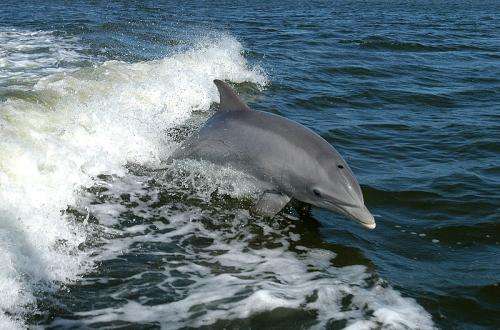Diving dolphins are exhalation champions

Every air-breathing marine mammal faces a multitude of challenges as it dives beneath the waves: carbon dioxide and nitrogen accumulation in the blood can cause intoxication and decompression sickness, while low internal pressures in rigid lungs can force blood into the delicate airways. Yet, whales, dolphins and seals rarely seem to suffer these ill effects. Andreas Fahlman from Texas A&M University - Corpus Christi, USA, says, 'It had been assumed that the respiratory systems of all marine mammals are similar with a stiff upper airway and collapsible lungs'. However, there was little evidence to support the assumption and Fahlman was repeatedly told that the measurements couldn't be made because of the incredibly high flow rates generated by exhaling dolphins.
That was until Fahlman met Micah Brodsky, a consultant and wildlife veterinarian with an interest in mechanical engineering. Brodsky decided to take on the challenge of designing a small and portable pneumotachometer (air flow meter) that could be used to measure flows in excess of 200 l/s in less than 100 ms and would survive corrosive salt water. After 9 months of development with the help of Trevor Austin, and knowing that the preliminary measurements couldn't be made in the wild, Fahlman and Brodsky travelled to Dolphin Quest Oahu, to work with bottlenose dolphins. Fahlman recalls that the sympathetic relationship between the dolphins and their trainers, led by Julie Rocho-Levine, was also essential for their success. However, even though the dolphins were trained to respond to their trainers' directions, they only participated voluntarily, 'Which allowed us to test important physiological variables with no stress to the animals', says Fahlman.
Placing the pneumotachometer over each dolphin's blow hole as it waited patiently in the water, Fahlman, Brodsky and Greg Levine measured the airway pressures and airflows as the animals breathed normally and heavily. They were impressed to see that the dolphins could inhale at flow rates of up to 33.4 l/s; however, when they measured the flow rate as the dolphins exhaled, they were astonished to register flows of up to 137.6 l/s. 'The cetaceans are the true champions of respiratory physiology', says Fahlman, putting the dolphins' performance into context by saying, 'The maximal flow rates are at least twice, and probably three times, higher than those in the terrestrial champion, the horse'. And when the team analysed the airflows, they realised that the animals could exchange almost all of the air in their lungs in a single breath: 'Their vital capacity is very high', says Fahlman, who publishes the discovery in The Journal of Experimental Biology.
Fahlman and Steven Loring also tested how rigid the dolphins' lungs were by calculating their compliance, and they were delighted to confirm Per Scholander's 70 year-old hypothesis that the lungs are compressible: rigid human lungs register a compliance of 0.08 per cmH2O while the dolphins' compressible lungs had a compliance of 0.31 per cmH2O. Fahlman also measured the amount of oxygen that the animals inhaled and exhaled and the carbon dioxide produced to calculate the animals' metabolic rates on a breath-by-breath basis. He explains that measurements like this could directly impact dolphin health. 'Lung function testing may be a novel way to investigate respiratory health of cetaceans under human care and we may be able to provide real-time information about oxygenation state and how animals are doing during a mass-stranding to help save animals', says Fahlman.
So, having overcome many technical challenges and measured the immense airflows generated by breathing dolphins, Fahlman is keen to study other cetaceans to learn more about their respiratory physiology and the effects of beaching on stranded animals.
More information: Fahlman, A., Loring, S. H., Levine, G., Rocho-Levine, J., Austin, T. and Brodsky, M. (2015). Lung mechanics and pulmonary function testing in cetaceans. J. Exp. Biol. 215, 2030-2038. jeb.biologists.org/lookup/doi/10.1242/jeb.119149
Journal information: Journal of Experimental Biology
Provided by The Company of Biologists

















